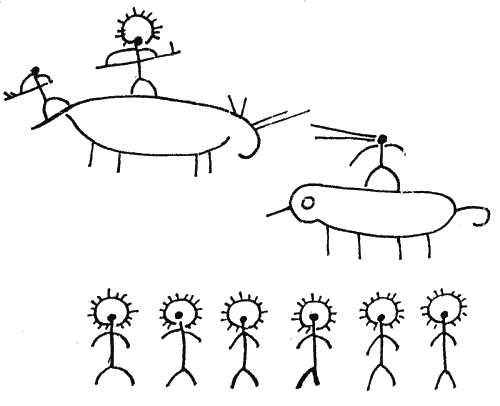Prehistoric cave drawings provide graphic evidence of the sublime artistic vision so revered by the ancestors of today’s Wanniyala-Aetto people.
Modern interpreters too often view indigenous art through the eyes and assumptions of patriarchal societies that engendered them. However, this was not necessarily the case.
And Lanka, an island ever since the last ice age, was even then long occupied by the lineage that early anthropologists termed as Veddas, who refer to themselves as Wanniyala-Aetto or ‘inhabitants of the forest’. The forest and its inhabitants all live together in balance. Evidence of prehistoric human settlements on the island dates back at least 125,000 years.

Vedda cave drawings such as those found at Hamangala provide graphic evidence of the sublime spiritual and artistic vision achieved by the ancestors of today’s Wanniyala-Aetto people. Most researchers today agree that the artistes most likely were the Wanniyala-Aetto women who spent long hours in these caves waiting for their menfolk’s return from hunting in the outside world.
Women, after all, were the keepers of the hearth and the masters of all sorts of liquid concoctions, including paints. This local knowledge was passed down from mother to daughter for uncounted generations, at least until now.
Understood from this perspective, these cave drawings depict brilliant feats of Wanniyala-Aetto culture as seen through the eyes of its womenfolk. The simple yet graceful and even elegant abstract figures are portrayed engaging in feats of vision and daring that place them firmly above even the fiercest of large beasts of their local habitat surrounding the cave.
The nimbus or halo about the human figures’ heads represents the sun’s disc and, equally, the sacred power bordering upon divinity that possesses great hunters. Even up to modern times, the Wanniyala-Aetto used to swear oaths of truth by the divinity of the sun, saying ‘upon Maha Suriyo Deviyo’.
Such cave drawings have long served as visual memory aids and as teaching tools for the transmission of ancestral wisdom traditions to succeeding generations. To this day, they provide silent testimony to the profound heights attained by Lanka’s indigenous culture expressed with elegant simplicity that people of all communities may appreciate.
Text by Patrick Harrigan, reproduced from SOBA journal, September 1993
Drawing courtesy of Gamini De S.A. Punchihewa from Souvenirs of a Forgotten Heritage
How did elephants reach islands like Sri Lanka?
We need to remember that the island of Sri Lanka has been connected to mainland India at many times in geological history. Roughly 10,000 years ago when the world was still in the grip of the last ice age, lot of sea water was locked up in ice in various parts of the earth. With lowered sea levels, shallow seas became exposed as land bridges, connecting various lands all around the world. Land bridge over Bering Straits that connected Siberia and Alaska is the most famous one. Land bridge over Palk Straits between Tamil Nadu and Sri Lanka is another one. Elephants and other animals from India must have just walked over to Sri Lanka. When ice age ended and new seas emerged (7000 years ago), they were trapped in the island.
“
“The first attempt at recording Rock Paintings and Engraving Sites (RPES) in Sri Lanka goes back to the last decades of the 19th century CE. H.C.P. Bell, the first Commissioner of the Archaeological Survey in Ceylon, has reported his observations on the painted rock-surfaces of two sites in the Polonnaruva District (Konnattegodagalge) (Figure 1 & Figure 2) and the Batticaloa District (Arangodagalge in the village Kohombalava ) in 1897. He had observed some ‘quaint outline drawings (men, animals, etc.) of the most primitive execution made in white ashes’ (Bell 1897:15; see also 1904). Bell is the pioneering force in reporting and commenting on the rock painting sites in the country. Till the end of 1904, thirteen RPES sites have been reported by him. The conclusion he made on the authorship of this tradition as ‘the most primitive execution drawn by Vädda (existing aboriginal community) artists’ (1904:94 emphasis in italics) has remained as one of the key conceptual formulations among the students of art history and prehistory in Sri Lanka to this day (v. Deraniyagala 1992). The work of C.G. Seligmann and B.Z. Seligmann (1911) on the subject has remained a path breaking venture.” https://www.bradshawfoundation.com/sri_lanka/rock_paintings_engraving_sites/index.php